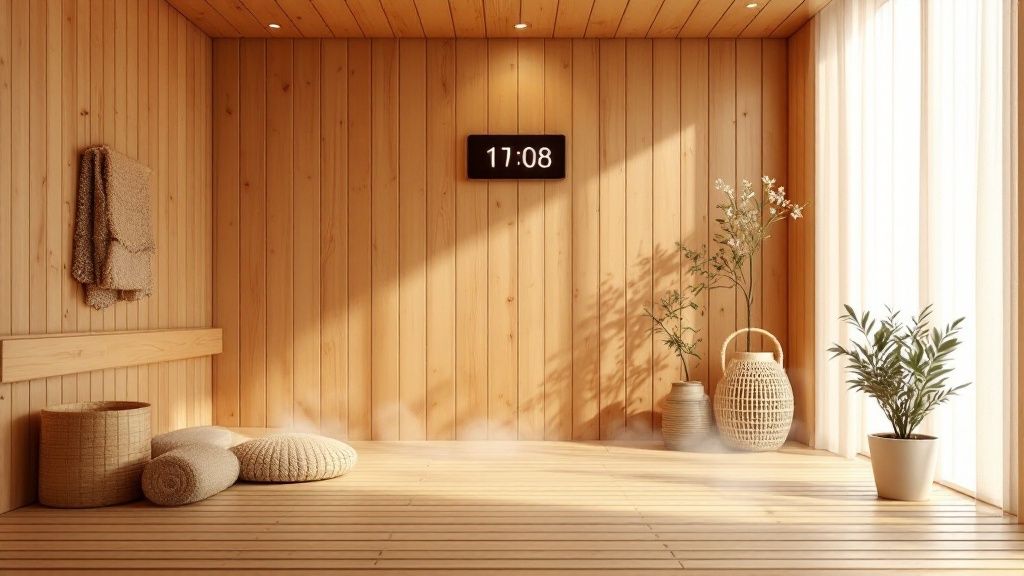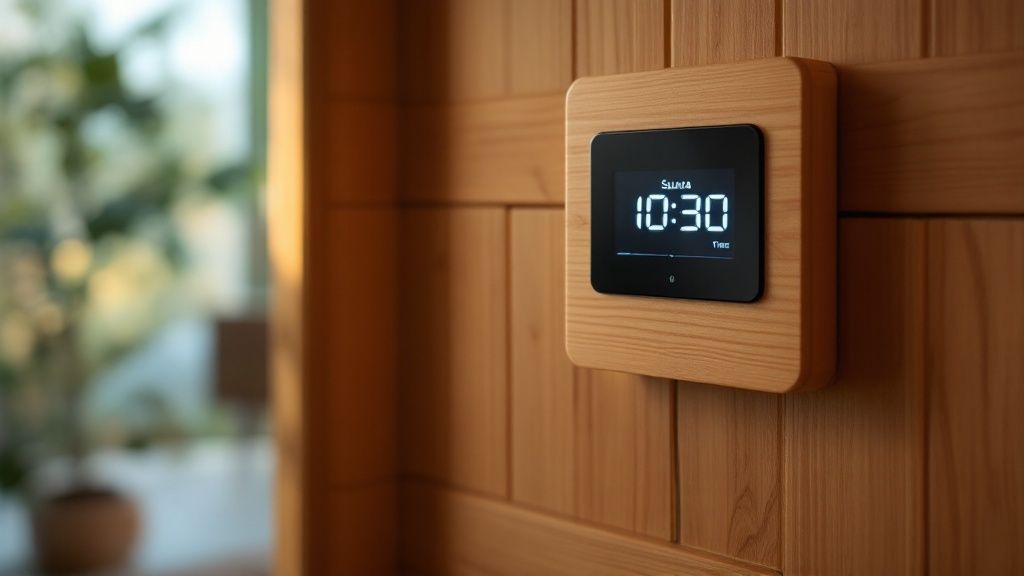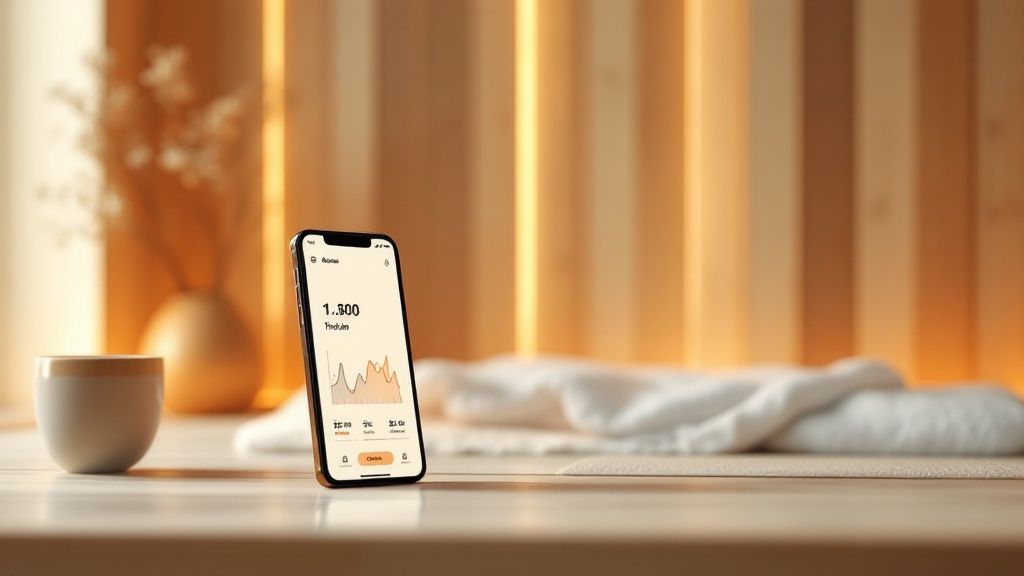How to Track Sauna Time for Maximum Wellness
- Sauna Tracker

- Mar 24
- 11 min read
Why Tracking Sauna Time Transforms Your Health

A sauna session offers a welcome escape and a chance to truly unwind. But beyond simple relaxation, the sauna can be a powerful tool for boosting your overall well-being. The key to unlocking its full potential lies in understanding the importance of timing. Precisely tracking your sauna time allows you to tailor the experience to your body's needs and maximize the health benefits. You can explore our sitemap for more blog posts for additional wellness information.
Understanding the Physiological Cascade
Your body responds to sauna heat in a series of distinct stages. Within the first 5 minutes, your body temperature begins to rise, increasing blood circulation and setting the stage for deeper physiological changes. By the 15-minute mark, your body enters a more intense detoxification phase, promoting sweat production and the elimination of toxins. This phased response underscores the importance of structured timing for a truly effective sauna session.
Timing For Specific Wellness Outcomes
Different sauna durations can produce different results. Shorter sessions, lasting 10-15 minutes, are often ideal for stress reduction and improved circulation. If you're aiming for muscle recovery and deeper detoxification, longer sessions closer to 20 minutes are generally recommended. These longer exposures allow for more significant physiological adaptations, such as increased blood flow to muscles and a greater release of endorphins.
The Adaptive Response and Amplified Results
Tracking your sauna time helps you harness your body's adaptive response to heat stress. This response follows a predictable pattern, and by understanding this pattern, you can optimize your sauna sessions for maximum benefit. Studies have shown that structured sauna use, compared to unstructured sessions, can amplify results by as much as 40%. Tracking your sauna time isn't simply about counting minutes; it's about monitoring your physiological changes and tracking the long-term health benefits. For more on tracking your sauna sessions effectively, check out this helpful resource: 5 Right Ways to Track Your Time in the Sauna.
Personalized Sauna Practice
Tracking your sauna sessions also empowers you to personalize your experience. By observing how your body reacts to different durations and temperatures, you can determine what works best for you. This personalized approach allows you to fine-tune your routine, optimizing it for your individual wellness goals. This consistent, targeted method transforms your sauna experience from a passive relaxation activity into a proactive health strategy.
The Science of Perfect Sauna Sessions: Timing Guidelines
Personalizing your sauna time is key to maximizing its benefits. There's no single perfect duration; the ideal sauna session depends on factors like your experience and the type of sauna you use. This section explores evidence-based recommendations to help you optimize your sauna routine.
Timing Variations Across Sauna Types
Different sauna types operate at varying temperatures and humidity levels, impacting the ideal session length. Traditional Finnish saunas, known for their dry heat, typically involve shorter, intense sessions. Experienced users might comfortably enjoy 15-20 minutes.
However, infrared saunas, with their lower temperatures, often lend themselves to longer sessions, sometimes 30-40 minutes, due to the gentler heat. This difference underscores the importance of understanding the specific effects of each sauna type.
Experience Level and Timing Strategies
Just as sauna types vary, so should your approach to timing. Beginners should always err on the side of caution, starting with shorter sessions and gradually increasing duration as their tolerance improves. A new sauna user might begin with just 5-10 minutes in a traditional sauna. The general recommendation is 15-20 minutes, but this can vary based on individual health and preference. This gradual acclimation helps the body adjust to the heat and minimizes potential risks.
To help guide your sauna experience, let's look at some general guidelines based on experience level and sauna type.
To help you plan your sauna sessions, the following table provides general guidelines based on experience level and the type of sauna:
Sauna Session Duration Guidelines This table compares recommended sauna times based on experience level and type of sauna.
Experience Level | Finnish Sauna | Infrared Sauna | Steam Room | Health Considerations |
|---|---|---|---|---|
Beginner | 5-10 minutes | 10-15 minutes | 5-10 minutes | Start slow and listen to your body. Consult a doctor if you have any health concerns. |
Intermediate | 10-15 minutes | 10-15 minutes | Gradually increase session duration as tolerance improves. Stay hydrated. | |
Experienced | 15-20 minutes | 25-40 minutes | 15-20 minutes | Monitor your body's response and adjust accordingly. Consider interval training. |
These are just guidelines, and individual tolerances may vary. Always listen to your body and adjust your sauna time as needed.
Tailoring Time for Specific Benefits
Your goals also play a role in determining the optimal sauna session length. Are you aiming for detoxification, performance enhancement, or relaxation? Each objective may benefit from a different approach.
For example, detoxification may involve longer sessions to encourage sweating. Conversely, stress reduction might prioritize shorter, more relaxing experiences.
Interval Training and the 72-Hour Rule
Some athletes incorporate interval training into their sauna routines, alternating between short bursts of heat and cooling periods. This method can boost cardiovascular performance and recovery. For intense sauna use, experts often recommend a 72-hour break between sessions to allow for full body recovery and adaptation. This prevents overstress and maximizes the benefits of each session. Tracking sauna time becomes crucial not only within sessions but for overall scheduling.
Essential Tools to Track Sauna Time With Precision

Tracking your sauna time accurately is key for both safety and maximizing the health benefits. Ordinary timers often can't handle the intense heat. This section explores a range of tools, from simple to sophisticated, designed to withstand sauna conditions and help you get the most from your sauna sessions.
Traditional and Analog Tools
Even with the rise of digital devices, traditional tools remain relevant in the sauna. Sauna sand timers, built for high heat, offer a simple and reliable timekeeping method. Their straightforward design avoids the risk of electronics failing due to heat and moisture. A waterproof analog watch kept just outside the sauna is another convenient low-tech choice, enabling quick time checks without exposing electronics to the heat.
Digital Timers and Apps
For those who prefer digital accuracy, dedicated sauna timers with large, easy-to-read displays are a great option. Many are designed for mounting outside the sauna, keeping them safe from the intense environment while still visible. Sauna apps offer even more. Apps like Sauna Tracker go beyond just timing, allowing you to log session details like sauna type, temperature, and even your physiological responses. This creates a comprehensive record of your sauna usage.
Wearable Technology
Smartwatches with heart rate monitoring take sauna tracking a step further. They provide real-time data on how your body responds to the heat, enabling you to adjust your session accordingly. Connecting your smartwatch with a dedicated sauna app lets you seamlessly combine time tracking with physiological data for a more holistic view of your sauna experience. This allows for a more personalized and data-driven approach.
Dual-Monitoring Systems
Many experienced sauna users opt for dual-monitoring systems. This involves using a timer to track the overall session length and a separate device, such as a smartwatch, to monitor heart rate and other physiological metrics. This combination ensures both accurate timekeeping and real-time health feedback, providing a deeper understanding of your body's reaction to the sauna and empowering you to tailor your sessions for optimal benefit.
Comparing Sauna Tracking Tools
To make the best choice for your needs, let's look at a comparison of different sauna time tracking tools. The table below highlights key features, durability, and price points to help you make an informed decision.
Sauna Time Tracking Tools Comparison: Comparing different tools for tracking sauna time based on features, durability, and price range.
Tracking Tool | Heat Resistance | Features | Price Range | Best For |
|---|---|---|---|---|
Sauna Sand Timer | High | Simple, reliable | Low | Basic time tracking |
Waterproof Analog Watch | Medium | Basic time tracking | Low-Medium | Quick time checks |
Digital Sauna Timer | High | Precise timing, some models offer additional features | Medium | Accurate time management |
Sauna App | N/A | Comprehensive tracking, data logging, personalized insights | Varies (often free) | Data-driven sauna use |
Smartwatch | Medium | Real-time physiological monitoring, app integration | Medium-High | Health-conscious users |
Dual-Monitoring System | Varies | Combined benefits of multiple tools | Varies | Experienced sauna users |
This comparison reveals the strengths of each tool, making it easier to pick the right one, or combination, for your sauna routine. By understanding the various options, you can build a tailored tracking system that prioritizes both safety and maximizing the benefits of your sauna sessions.
Building Your Personal Sauna Tracking System

Integrating sauna sessions into a wellness routine involves a systematic approach to tracking your sauna time. It's more than just enjoying the heat. It's about monitoring the entire heat exposure equation: temperature, humidity, recovery intervals, and even your subjective experience. Developing a personalized tracking system helps you optimize your sauna sessions for maximum benefit.
Key Elements of a Comprehensive Tracking System
A well-rounded tracking system provides a holistic view of your sauna experience. It goes beyond simply recording the time spent inside. Consider these key elements:
Temperature and Humidity: Recording these metrics helps you understand your body's response. A higher temperature, for instance, might mean a shorter session.
Session Duration: Tracking the length of each session is fundamental. This allows you to monitor your progress and adjust as needed, especially if you are new to sauna use.
Recovery Intervals: Cooling down between sessions is crucial. Adequate recovery is vital, especially after intense heat exposure, to prevent overstress and maximize the benefits.
Subjective Experience: How did you feel? Noting your subjective feelings – relaxed, energized, or otherwise – connects your physiological responses with your overall experience.
Learning From Dedicated Practitioners
Experienced sauna users understand the value of structured tracking. Many keep detailed logs of their sessions, noting not only the basic metrics but also factors like hydration levels and pre-sauna activities.
This meticulous tracking helps identify patterns and fine-tune their routines. They often discover their personal thresholds for both diminishing returns and peak benefits, personalizing their sauna experience with greater precision.
Utilizing Templates and Tools
Building your personal system is easy with readily available resources. Many sauna coaches offer downloadable templates designed to track key variables. These templates may also incorporate often overlooked factors like time of day and pre-sauna preparation.
Apps like Sauna Tracker simplify the process. They let you log session details, monitor metrics, and analyze trends over time. This empowers you to identify patterns and personalize your experience for maximum benefit.
Optimizing Your Personal Heat Exposure
By combining meticulous tracking with analysis, you can transform your sauna practice. You can learn how factors like hydration, time of day, and even pre-sauna meals influence your experience.
This allows you to personalize your approach and optimize your heat exposure for specific wellness goals. Whether your goal is relaxation, detoxification, or performance enhancement, tracking empowers you to harness the power of the sauna for optimal wellness.
Safety Protocols When Tracking Your Sauna Journey
Tracking your sauna sessions is a great way to maximize the benefits, but remember, safety always comes first. Even with precise timing, listening to your body is key. Sometimes, your body will tell you to cut a session short, even if your timer hasn't gone off. Understanding these physiological cues is just as important as tracking the minutes you spend in the sauna.
Recognizing Critical Physiological Signals
While a timer is helpful for managing your sauna session, your body provides the most important feedback. Heart rate variability is a significant indicator of how well you're tolerating the heat. A rapid or erratic heartbeat could mean you're overheating and should exit the sauna immediately, no matter how long you've been inside. For instance, a significant spike above your resting heart rate is a clear sign it's time to cool down. Also, be aware of cognitive changes. Dizziness or disorientation are clear signals that your body needs a break.
Non-Negotiable Safety Parameters
Seasoned sauna goers know that time is only one factor to consider. They pay attention to a range of elements, including hydration levels and core body temperature. Dehydration is a serious risk during longer sauna sessions, so maintaining proper hydration is critical. This involves monitoring your fluid intake before, during, and after each session. Experienced users also recognize subtle warning signs like unusual fatigue or nausea. These seemingly small signs can indicate a need to step out of the sauna. For additional guidance on optimizing your sauna experience, you can check out this resource: How to master your sauna experience.
Calculating Appropriate Rest Intervals
Recovery between sauna sessions is just as vital as the sessions themselves. The ideal rest interval length varies depending on individual health and the intensity of the sauna session. A 72-hour break is frequently recommended between intense sessions to ensure your body has fully recovered. This helps minimize the cumulative effects of heat stress and maximizes the benefits of each sauna session. Less intense sauna use may allow for shorter rest periods.
Checklists for Different Populations
Different groups have specific needs when it comes to sauna safety. Athletes using saunas for performance enhancement may handle longer sessions, but they still need to be mindful of proper hydration and careful monitoring. People with pre-existing health conditions should consult a doctor before using a sauna, as modifications to standard practices may be necessary.
Unexpected Warning Signs
Even experienced sauna users can overlook subtle but important warning signs. Tingling skin or muscle cramps may indicate an electrolyte imbalance, which needs immediate attention. Ignoring these apparently minor issues can sometimes lead to more serious complications, highlighting the importance of staying attuned to your body's feedback.
Sample Sauna Safety Checklists
To help you stay safe, here are some sample checklists:
General Sauna Safety:
Hydrate well before, during, and after your session.
Start with shorter sessions and gradually increase duration as tolerated.
Avoid alcohol or medications that could impact your body's response to heat.
Never use a sauna alone.
Listen to your body and exit immediately if you feel uncomfortable.
Sauna Safety for Athletes:
Monitor your heart rate closely.
Replenish electrolytes lost through sweat.
Get enough rest and recovery between sessions, especially after intense training.
Adjust sauna duration and temperature according to your training load and overall recovery.
Sauna Safety for Individuals with Health Considerations:
Consult with your doctor before using a sauna.
Start with very short sessions and monitor your body's reactions carefully.
Avoid extreme temperatures.
Pay close attention to any unusual symptoms and leave the sauna right away if you have any concerns.
By prioritizing these safety protocols, you can ensure your sauna experience is both enjoyable and beneficial to your well-being. These proactive steps will help make each sauna session a positive contribution to your health.
Advanced Timing Strategies For Breakthrough Results
Timing your sauna sessions strategically can significantly enhance the benefits. This goes beyond simply tracking the minutes inside and delves into understanding when and how to schedule your sauna time for optimal results. Let's explore some research-backed approaches that work with your body's natural rhythms and responses to heat.
Timing Sauna Sessions Around Workouts and Sleep
Strategic timing can amplify the effects of your sauna sessions. Consider scheduling them around your workouts. A post-workout sauna can aid muscle recovery by increasing blood flow to tired muscles. However, avoid the sauna immediately after an intense workout.
Give your body at least 10 minutes to cool down first. This allows your body to regulate its temperature effectively. The timing of sauna sessions relative to sleep is also crucial.
An evening sauna can promote relaxation and better sleep, while a morning sauna might boost alertness and energy levels. Experiment to find what works best for you and your body.
Circadian Considerations and Interval Protocols
Your circadian rhythm, your body's internal clock, influences how your body responds to heat. An evening sauna session may improve relaxation and sleep quality, while a morning session could enhance alertness and focus.
Interval protocols, alternating between heat exposure and cooling periods, offer another way to optimize sauna use. These protocols can be particularly effective for cardiovascular health and performance enhancement.
Alternating heat with brief cool-down periods challenges your body’s thermoregulatory system. This leads to adaptations that benefit overall fitness. A typical protocol might involve 15 minutes in the sauna followed by a 5-minute cool shower, repeated two or three times.
Hormonal Fluctuations and Sauna Timing
Hormonal fluctuations throughout the day and your monthly cycle can influence how your body responds to sauna use. Cortisol levels, which influence stress response, are typically highest in the morning.
A morning sauna session could potentially moderate these levels and contribute to reduced stress. For women, hormonal changes during the menstrual cycle might affect sauna tolerance and benefits. Tracking your sauna time and observing how you feel during different hormonal phases can help you optimize your routine.
The Finnish Sauna Tradition
Finnish sauna masters often recommend counterintuitive timing patterns. They might suggest shorter, more intense sessions with multiple entries and exits during a single visit. This traditional approach maximizes the benefits of intense heat while allowing frequent cooling-off periods.
This practice is often followed by a cool plunge in a lake or pool, further stimulating the body and enhancing the overall experience.
By considering these advanced timing strategies, you can optimize your sauna experience and achieve breakthrough results aligned with your wellness goals. Ready to optimize your sauna experience? Download Sauna Tracker today and start tracking your sauna time.

.png)